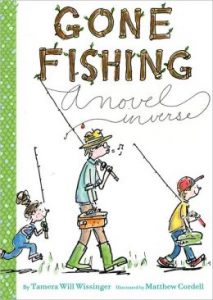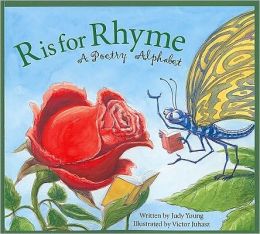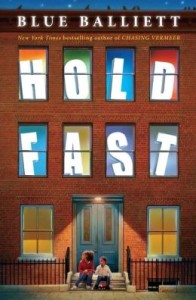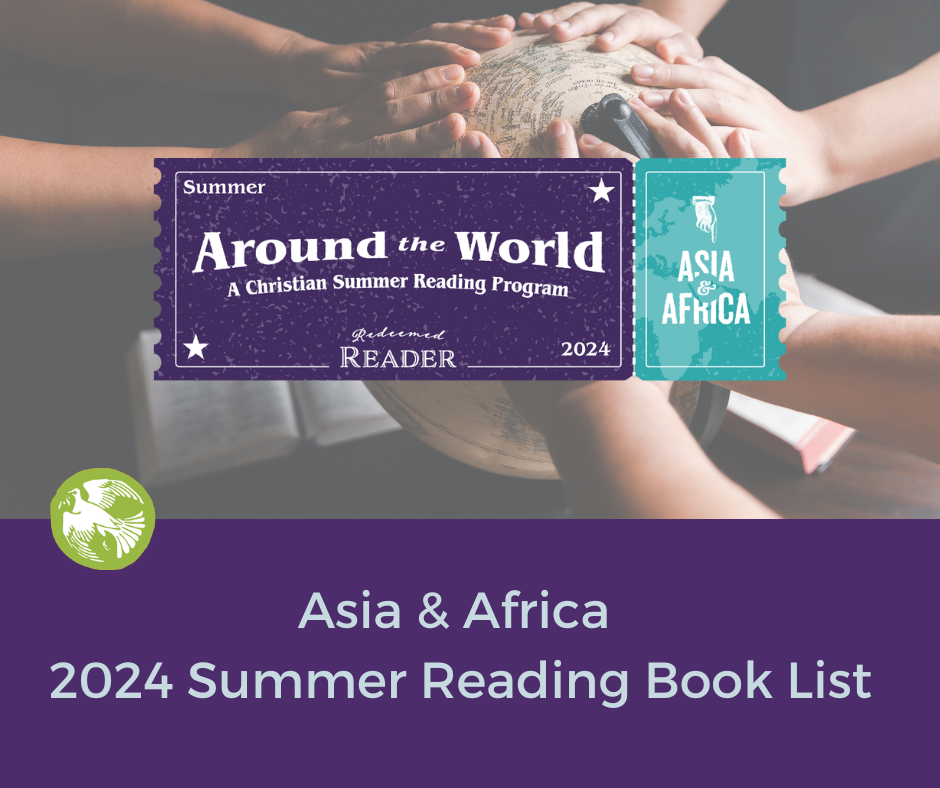We’re rounding out our Poetry Month coverage with three books for middle-graders:
Gone Fishing: a Novel in Verse, by Tamera Will Wissinger, illustrated by Matthew  Cordell. Houghton Mifflin, 2013, 120 pages. Age/interest level: 6-up.
Cordell. Houghton Mifflin, 2013, 120 pages. Age/interest level: 6-up.
The night before, Sam and his dad hunted night crawlers: Grass slick/ Worms thick/ tiptoe near and grab them quick. (This is an example of Tercet Variation) Sam is looking forward to some guy time at the lake, but when his little sister asks to go, and Dad says yes, Sam sings the Can’t Go Fishing Yet Blues (Blues Poem). His mood doesn’t improve when Lucy crinkles candy wrappers and reads her books aloud on the boat: She cannot be quiet!/ It’s worse than I feared./ This day would be perfect if . . . / she disappeared. (Lament)
And to cap it off, Lucy starts catching all the fish! Sam hooks a baseball cap, then a big something-or-other that got away. But then, finally-
I’m catfish strong!/ I caught that lunker. Yee-haw! Wham!/ I’m catfish strong! I could’ve wrestled all day long . . .
(And that’s an example of a rondolet.) It turns out to be a great day and a pretty good little sister and a very nifty way to introduce kids to various poetry forms, such as free verse, quatrain, concrete, limerick, and more. All these are explained in the appendix, along with techniques and tools, such as Metaphor, alliteration, Hyperbole, etc. Even the bibliography looks like fun. The illustrations are loose, comic style line drawings that enhance the fun. Verse novels are generally the purview of YA fiction, or if not, they tend to be edgy or depressing (see Newbery-award-winning Out of the Dust for an example). But Going Fishing explores the fun and variety of word play. if it doesn’t get a boy or girl hooked on poetry, I don’t know what will.
- Worldview/moral value: n/a
- Literary value: 5
R is for Rhyme: a Poetry Alphabet, by Judy Young, illustrated by Victor Juhasz. Sleeping Bear Press, 2005, 46 pages. Age/interest level: 6-10.
A poet uses many tools
to build a house of words.
To say the things the poet wants
to be both seen and heard.
This picture book takes the same general approach as Going Fishing (teaching poetry forms by example), but organized by the alphabet instead of a sustained narrative. A is for Acrostic, B is for Ballad, C for Cinquain, D for Doublet, and so on. A sidebar for each letter explains the form, shows how it works in the author’s example, and often cites examples from well-known poets that the reader can look up. Some famous poets are mentioned, and some are even caricatured in the light-hearted illustrations.
Most of the sidebars also end with a question, which will either take the reader back to the poem to see how it works, or inspire the reader to write a poem of his own. With all the explanation, references, and questions R is for Rhyme is more “teachery” than Going Fishing, but still fun, and it could serve as the text for a poetry unit all by itself.
- Worldview/moral value: n/a
- Literary value: 4
Hold Fast, by Blue Balliett. Scholastic, 2013, 288 pages. Age/interest level: 8-14.
Blue Balliett is known for folding mysteries into creative human endeavors such as art (Chasing Vermeer), architecture (The Wright 3), and biology (The Danger Box). The matrix of Hold Fast is poetry, particularly the poetry of Langston Hughes:
Hold fast to dreams/for if dreams die
life is a broken-winged bird/that cannot fly.
Hold fast to dreams/for when dreams go
life is a barren field/frozen with snow.
In the Woodlawn area of Chicago lives a tight-knit family: Dashel and Summer Pearl, 11-year-old Early and 4-year-old Jubilation (Jubie). Dash, as his kids call him, is the soul and heartbeat of his family, a poor-but-honest page at the Harold Washington Public Library, a lover of words and puzzles, and an amazing reader, a gifted and hungry thinker. The novel opens with common English words and their definitions, which will become chapter headings, benchmarks, and clues.
Dash’s dream is to get a library degree and move up the salary ladder so he can buy a home for his beloved wife and kids. When he’s offered a chance to make some extra money on the side, and maybe hurry up that dream a little bit, it’s too sweet to pass up. But the purported dealer in rare books is actually engaged in diamond smuggling, leading to Dash’s disappearance in the middle of a cold Chicago winter. Bad leads to worse when his family is hounded out of their apartment and thrown into the downward spiral of emergency housing. Summer falls apart and Jubie is just a little kid, so it’s up to Early to unravel the secret hidden in a volume of Langston Hughes’ First Book of Rhythms.
There’s a lot going on here; probably too much to give it all due respect. The central mystery of diamond smuggling begins to feel almost like an afterthought. The heart of the story is the Pearls’ descent into homelessness, and here the narrative shines: being without a permanent home is an experience most of us have (thankfully) avoided, but it’s a way of life for some, and may become more common. Early’s resolve to “Hold fast to dreams” is severely tested, but she perseveres through faith—faith in Dash and the resilience of their family rather than God. Misplaced faith turns the story into something more like a fairytale, though I appreciate the happily-ever-after ending. It may be too sad in places for some readers—parental discretion advised for that, plus a brief interlude of violence when the Pearls’ apartment is broken into.
- Worldview/moral value: 4 (out of 5)
- Literary value: 4
Betsy reviewed a verse novel for young adults earlier this week. If you’re looking for a good poetry anthology for your reference shelf, Megan has some recommendations for you. If you’re just catching up with us, see Betsy’s first post for poetry month, and don’t forget to check out the links.
Stay Up to Date!
Get the information you need to make wise choices about books for your children and teens.
Our weekly newsletter includes our latest reviews, related links from around the web, a featured book list, book trivia, and more. We never sell your information. You may unsubscribe at any time.
Support our writers and help keep Redeemed Reader ad-free by joining the Redeemed Reader Fellowship.
Stay Up to Date!
Get the information you need to make wise choices about books for your children and teens.
Our weekly newsletter includes our latest reviews, related links from around the web, a featured book list, book trivia, and more. We never sell your information. You may unsubscribe at any time.
We'd love to hear from you!
Our comments are now limited to our members (both Silver and Golden Key). Members, you just need to log in with your normal log-in credentials!
Not a member yet? You can join the Silver Key ($2.99/month) for a free 2-week trial. Cancel at any time. Find out more about membership here.



